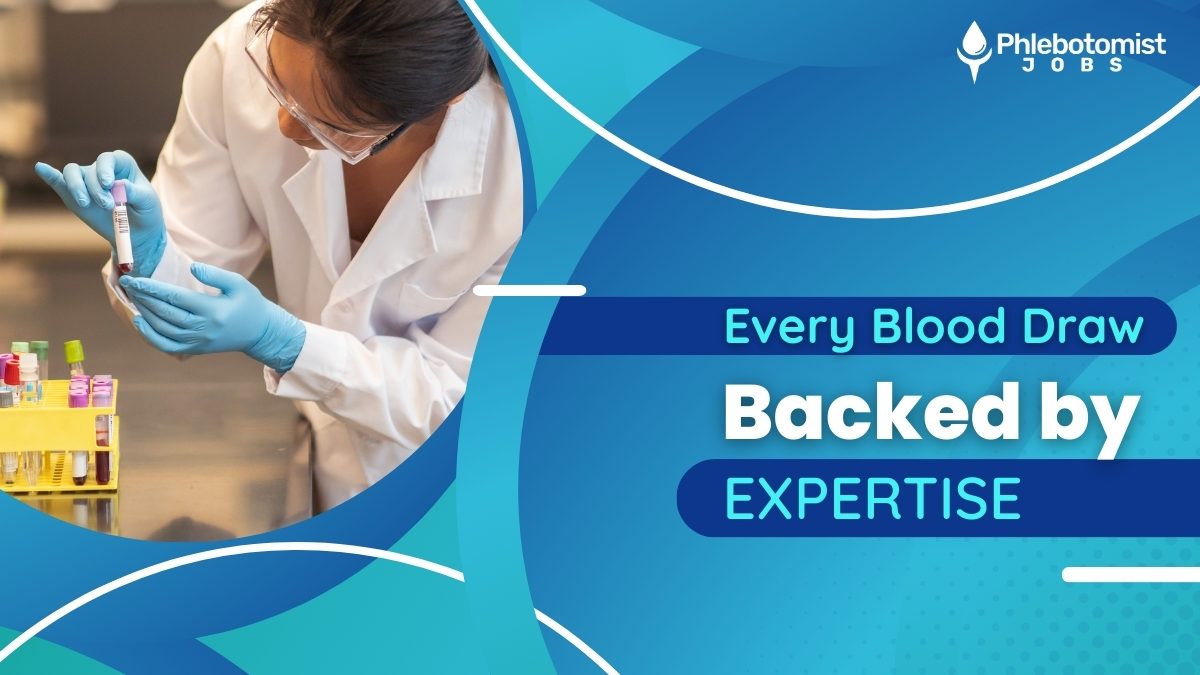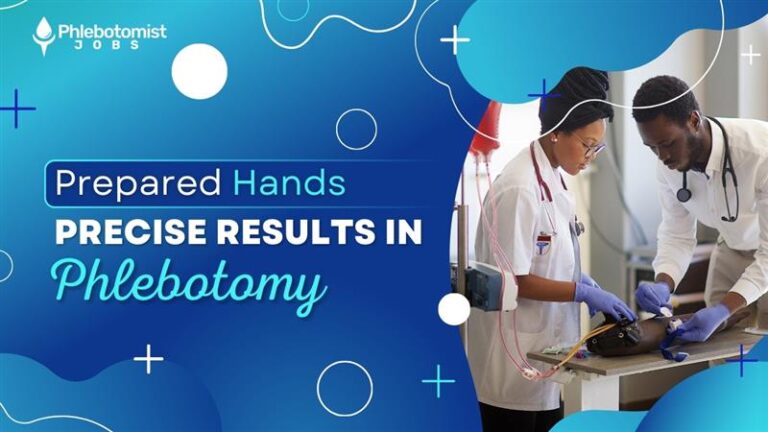Table of contents ▸
The field of phlebotomy offers rewarding Phlebotomist Jobs for those who are passionate about healthcare and patient care. Yet, the qualifications can be rather confusing because terms like “licensed” and “certified” are often used interchangeably. While both licensed phlebotomists and certified phlebotomists work as Professional Phlebotomists in the areas of skill and expertise, they differ concerning their training, legal requirements, and career paths. We seek to differentiate one from the other so that aspiring professionals with Phlebotomy Jobs pending before them can make an informed decision about stepping into a promising, growing field.
What is a Certified Phlebotomist?

Simply put, a certified phlebotomist is someone who has undergone accredited phlebotomy training and has passed the certification test given by an accrediting body like the National Phlebotomy Association (NPA), the American Society for Clinical Pathology (ASCP), or the American Medical Technologists (AMT). Certification confirms that a phlebotomist is competent in performing venipuncture, specimen custody procedures, safety protocols, and patient comfort.
Certification Process
The itinerary for becoming a certified phlebotomist includes these major steps:
- Enroll in a Training Program: The candidate takes an accredited phlebotomy course, typically lasting anywhere from a few weeks to a year in time. These programs include venipuncture technique, patient interaction, laboratory safety, and infection control.
- Hands-On Experience: One usually has to complete 50-100 successful blood draws during clinical training in order to gain their clinical experience.
- Pass the Certification Exam: One must pass a standardized examination of theoretical and practical knowledge involved in phlebotomy.
- Maintenance of Certification: Certain certificates require renewal every one or two years through continuing education or re-testing to ensure that the certified remains competent.
Benefits of Certification
Certification provides the greatest access to a phlebotomy job. Hospitals, clinics, and diagnostic laboratories hire certified phlebotomists for their proven skills and for working to industry standards. Certified phlebotomists earn an average of $18.10 per hour in 2025, with the potential for higher earnings in high-demand locations such as urban hospitals or specialty clinics.
Certification opens many other avenues in phlebotomy, including mobile phlebotomist or phlebotomy supervisor positions and positions in blood donation centers.
Limitations of Certification
Certification has value, but it is not always legally mandated. Some states will allow an uncertified individual to conduct a blood draw under certain conditions, which may lessen the apparent need for certification in some areas. On the other hand, lack of certification limits the job opportunities open to the Professional Phlebotomist as well as career advances that can be realized.
What is a Licensed Phlebotomist?

The licensed phlebotomist has a license issued by the state, controlled by the states of California, Nevada, Louisiana, and Washington. The licensing of phlebotomists is a legal mandate, enforcing that those who perform blood draws must be those who are licensed. It is more stringent than certification, requiring training, and ability to abide with state regulations.
Licensing Process
Generally, a candidate for licensure follows this procedure:
- Complete State-Approved Training: Enroll in a program that fulfills the state requirements, such as for California, where the minimum hours are 40 hours of classroom training and 40 hours of clinical practice.
- Perform Clinical Practice: A certain minimum number of venipunctures and capillary punctures have to be done, duly verified by a supervisor, to show competency.
- Pass a State Exam: Some states demand a specific exam, which is different from national certification exams, for verification of local standards.
- Apply for a License: Submit a file, describing the personal background in training and experience, along with results of an examination, to the health department in the particular state.
- Renew the License: Licenses need to be renewed every 1-2 years, sometimes accompanied by some credits for continuing education.
Benefits of Licensing
In states where the license is required, a licensed phlebotomist holds a great advantage over finding any Phlebotomy Jobs. Employers tend to favour them so that they may abide with state laws, thus guaranteeing a steady demand for Phlebotomy Opportunities. For example, licensed phlebotomists can earn up to $25 an hour in California, especially around the high-demand areas like Los Angeles or San Francisco.
In addition, licensing denotes a commitment to top-tier standards of care and safety for the very thing that builds the trust of employers and patients alike. Licensed phlebotomists are also in demand for specialized assignments, such as working in oncology laboratories or with pediatric patients, enabling them to broaden their career possibilities.
Licensing Hurdles
It is a fairly long and expensive process, as the actual training and licensing fees could well go past $1,000. In addition, licensing only being mandatory in some states restricts the return on investment for those training to be licensed phlebotomists, should they relocate to non-licensing states; rather a poor choice if one is looking for flexibility in Phlebotomist Jobs.
Differences Between Licensed and Certified Phlebotomists
The differences between licensed vs certified phlebotomists bear on legal requirements, geographic scope, and career implications.
Legal Requirements
- Certified Phlebotomist Laws: Voluntary in most states, given by national organizations, may not legally be required to practice.
- Licensed Phlebotomist Laws: Compulsory in some states, regulated by state departments of health, and required by law to perform phlebotomy.
Geographic Scope
- Certified Phlebotomist: Has national recognition, making its holders more marketable for Phlebotomist Jobs in other states.
- Licensed Phlebotomist: Could be administered by state laws, which would necessitate acquiring an additional license to work in other regulated states.
Career Implications
- Certified Phlebotomist: Widely accepted for entry-level Phlebotomy Jobs and grounds for assembly-type jobs like phlebotomy supervisor, or to enable transition to other healthcare occupations.
- Licensed Phlebotomist: Is needed for some phlebotomy positions in regulated states, which further enables more meaningful functions in settings with high demand.
Cost and Time
- Certified Phlebotomist: Program fees roughly $500-$2,000, This being a generally shorter program.
- Licensed Phlebotomist: More expensive and time-intensive, as it is governed by the laws and regulations of each state.
Choosing the Right Path for Your Career
Wherever you are positioned, the choice of going for certification or going for a license will be made with your career in mind. Licensed Phlebotomists can only undertake Phlebotomy Jobs in states requiring a license. In other states that do not demand it, a certified phlebotomist will open many Phlebotomy Opportunities. Most Professional Phlebotomists go for both to enhance employability and flexibility in different regions. Platforms like Phlebotomist Jobs provide information like listings and career advice to help you find Phlebotomist Jobs that suit your qualifications.
Conclusion
It’s very necessary to understand what differentiates a licensed phlebotomist from a certified phlebotomist in order to build a worthwhile career in phlebotomy. Certification is a kind of national recognition which allows an individual to seek out diverse Phlebotomy Jobs; whereas a License is a law in some states and will be a considerable advantage for a candidate when he makes it to markets where this licensing is mandatory. Thus, a few of the rewarding phlebotomy avenues will open up for the candidate when he/she has the appropriate credentials and are ready to accommodate his/her skills in the fast-growing environment.
Follow us on Social Media: LinkedIn | Facebook | Twitter | Instagram












